Studio Visit: Cannon Design
- Autore
- John Hill
- Pubblicato il
- mag 7, 2012
"Power House" is the intriguing name of Cannon Design’s St. Louis, Missouri, office. It's also an apt moniker considering that the impressive brick edifice once served as a coal-fired steam power station for a dozen downtown buildings. The 1928 structure, which stood vacant for three decades before Cannon Design bought it in 2007, now houses 90 employees on four floors. On a sunny and mild winter day earlier this year World-Architects visited the Power House—designed by the firm’s associate principal, David Polzin— and was given a tour from George Nikolajevich, design principal of Cannon Design's St. Louis office.
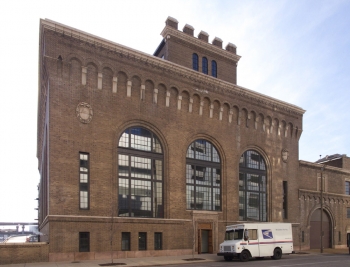
Power House, exterior. Photo: John Hill
Approaching the building from the northeast, I was struck by the huge two-story arched windows that fit into the castle-like brick walls. These strong yet graceful openings bring plenty of daylight into the cast-iron-columned space, formerly a home to pigeons, as George later explained. The birds are gone and in its place are architects and engineers moving about the new floors inserted into the impressive space.
The tall windows only hint at the grand scale of the interior, which is slowly revealed through an entry sequence that involves two 90-degree turns before depositing visitors in the reception area at the base of a three-story open space. From here, the scale of the Power House’s large volume of space is undeniable. New curving floor plates—accentuated by solid guardrails—are held back from the exterior to open up the office on the eastern facade and bathe the offices in morning sunlight.
The tall windows only hint at the grand scale of the interior, which is slowly revealed through an entry sequence that involves two 90-degree turns before depositing visitors in the reception area at the base of a three-story open space. From here, the scale of the Power House’s large volume of space is undeniable. New curving floor plates—accentuated by solid guardrails—are held back from the exterior to open up the office on the eastern facade and bathe the offices in morning sunlight.
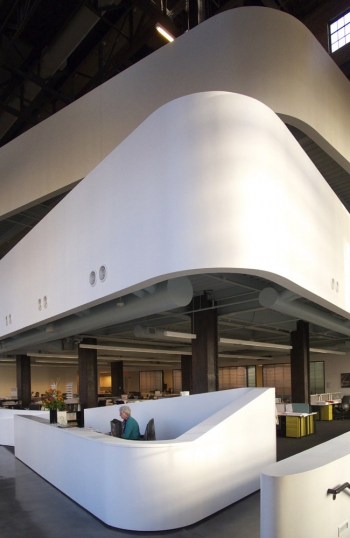
Power House, interior reception. Photo: John Hill
After meeting in the reception area and taking in the grandeur of the space, George and I started our walk up through the building. It became evident in our walk-and-talk that a synergy exists between the building and the firm that occupies it. President Kent Turner’s decision to save and adaptively reuse the building as Cannon Design’s offices is a clear expression of the firm's belief in green architecture, what George described as "very important," on par with the "art of architecture" that Cannon tries to maintain.
Compared to their previous office on the top floor of a nearby developer building, the Power House is artfully superior, not only in how it inserts itself into the old building and sets up a dialogue between old and new, but also in how it creates a quality space for its employees. This decision to retrofit an old building is also a meaningful investment in a downtown that is still struggling to bring people back from last century’s suburban exodus. Plus, the Power House's transformation makes economic sense—the bank loan was lower for a historical building in St. Louis than for a newer one.
Compared to their previous office on the top floor of a nearby developer building, the Power House is artfully superior, not only in how it inserts itself into the old building and sets up a dialogue between old and new, but also in how it creates a quality space for its employees. This decision to retrofit an old building is also a meaningful investment in a downtown that is still struggling to bring people back from last century’s suburban exodus. Plus, the Power House's transformation makes economic sense—the bank loan was lower for a historical building in St. Louis than for a newer one.
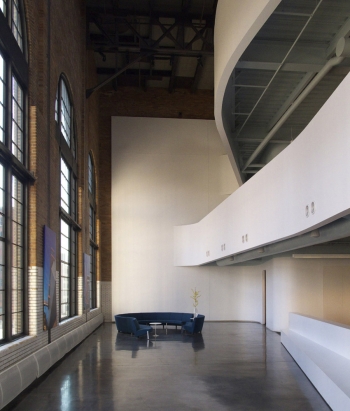
Power House, interior. Photo: John Hill
Cannon Design has 15 offices internationally, all but two of them in North America. Cannon’s growth has happened through acquiring the right firms at the right times, a strategy that no doubt helped the company thrive during the recent economic slump, a subject I bring up on the tour.
“We’re extremely lucky,” George said, referring to the fact that Cannon only laid off a few employees, and has actually been hiring for the St. Louis office. Though he admits to not being sure why the company fared better than most, surely some of the success can be attributed not only to their acquisitions but to their portfolio and expertise in health care and education buildings, two sectors that are actually booming these days.
The company was founded in 1945 in Buffalo, New York, but since 1995 Cannon Design has operated a "single-firm, multi-office" structure, meaning each office is different and that no single office serves as a headquarters. George tells me that through acquisition Cannon Design wants each office to "keep its soul, atmosphere," and to a certain degree, its destiny.
“We’re extremely lucky,” George said, referring to the fact that Cannon only laid off a few employees, and has actually been hiring for the St. Louis office. Though he admits to not being sure why the company fared better than most, surely some of the success can be attributed not only to their acquisitions but to their portfolio and expertise in health care and education buildings, two sectors that are actually booming these days.
The company was founded in 1945 in Buffalo, New York, but since 1995 Cannon Design has operated a "single-firm, multi-office" structure, meaning each office is different and that no single office serves as a headquarters. George tells me that through acquisition Cannon Design wants each office to "keep its soul, atmosphere," and to a certain degree, its destiny.
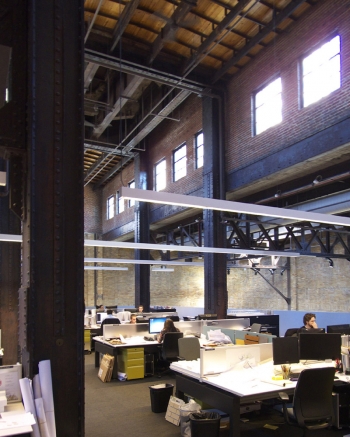
Power House, third floor. Photo: John Hill
Cannon Design's St. Louis office is shaped by key principals like George, but also by architects like David Polzin, who is responsible for much of the Power House’s design. David joins the tour as we head to the top-floor meeting room and lounge area. From this vantage point, the industrial nature of the old building really shines through. David explains that it was important to preserve and express as much of the original building as possible, especially the strong structural columns that land in the middle of the floor plates and give each level a unique sense of scale.
George and David presented a slideshow of recently completed buildings as well as some "on the boards." All of the projects came out of Cannon Design's St. Louis office, but they are international in scope, including projects in South America and Canada, as well as different parts of the United States. Below are a few projects presented that day:
George and David presented a slideshow of recently completed buildings as well as some "on the boards." All of the projects came out of Cannon Design's St. Louis office, but they are international in scope, including projects in South America and Canada, as well as different parts of the United States. Below are a few projects presented that day:

INCA Instituto Nacional de Cancer, Rio de Janiero, Brazil. Renderings courtesy Cannon Design.
INCA Instituto Nacional de Cancer, Rio de Janeiro, Brazil, estimated completion: 2014:
George was clearly proud of his design for this large project that will serve low-income families in a dense area of Rio de Janeiro. The design builds on his experience in health care design and centers around a public green space -- a garden that is adjacent (and atop) outpatient facilities. An L-shaped wing houses the in-patient rooms, which also overlook the green space. While many health care facilities wall themselves off from their urban milieu, the INCA admirably makes a public space an integral part of its design.
George was clearly proud of his design for this large project that will serve low-income families in a dense area of Rio de Janeiro. The design builds on his experience in health care design and centers around a public green space -- a garden that is adjacent (and atop) outpatient facilities. An L-shaped wing houses the in-patient rooms, which also overlook the green space. While many health care facilities wall themselves off from their urban milieu, the INCA admirably makes a public space an integral part of its design.

University Hospitals, Seidman Cancer Center, Cleveland, Ohio. Photographs courtesy Cannon Design.
University Hospitals, Seidman Cancer Center, Cleveland, Ohio, completed 2011:
This recently completed building is located on the corner of University Hospital grounds and adjacent to Case Western Reserve University. The design responds to its context by having the facade gently slope up from the linear park next door. Like the INCA, the design responds to the different spaces: on the lower floors the outpatient rooms overlook the "healing garden" formed by the sloping wall. Light and views help shape the building, resulting in a strong image for the hospital.
This recently completed building is located on the corner of University Hospital grounds and adjacent to Case Western Reserve University. The design responds to its context by having the facade gently slope up from the linear park next door. Like the INCA, the design responds to the different spaces: on the lower floors the outpatient rooms overlook the "healing garden" formed by the sloping wall. Light and views help shape the building, resulting in a strong image for the hospital.
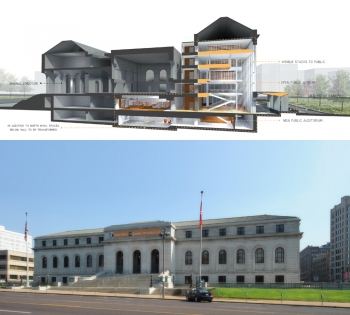
St. Louis Public Library, Central Library Renovation, St. Louis, MO. Rendering (top) and photograph courtesy Cannon Design.
St. Louis Public Library, Central Library Renovation, St. Louis, Missouri, estimated completion: Summer 2012:
Visitors to St. Louis's Central Library will soon move through a 21st-century space as they access the 100-year-old building. Cannon Design's nearly completed renovation of the Cass Gilbert-designed building involved removing obsolete book stacks in the north wing and replacing them with new floors overlooking a large atrium. A new entry pavilion adjacent to the atrium reorients the main entrance to the north side, which faces Lucas Park.
John Hill
Visitors to St. Louis's Central Library will soon move through a 21st-century space as they access the 100-year-old building. Cannon Design's nearly completed renovation of the Cass Gilbert-designed building involved removing obsolete book stacks in the north wing and replacing them with new floors overlooking a large atrium. A new entry pavilion adjacent to the atrium reorients the main entrance to the north side, which faces Lucas Park.
John Hill

Cannon Design
"Founded over sixty-five years ago, Cannon Design is ranked among the leading international architectural, engineering and planning firms in planning and design for healthcare, research, education, corporate, sports and government clients. The firm employs a staff of over 1,000, delivering services in 15 offices throughout North America, as well as in Shanghai, China and Mumbai, India. Long recognized as one of the world’s leading international practices, the firm, overall, is ranked the 11th largest in the world, according to World Architecture’s 2012 global survey. As an Ideas Based Practice, Cannon Design has been honored with over 300 awards for design excellence, technological innovation, and creative thought leadership.
"Cannon Design’s unique Single-International Firm, Multi-Office practice approach enables the full integration of all of our offices into a unified firm without walls. This methodology offers clients around the world consistent access to the full resources of the organization, irrespective of location. As such, the practice services clients across North and South America, as well as Europe, the Middle East, India and Asia."
"Founded over sixty-five years ago, Cannon Design is ranked among the leading international architectural, engineering and planning firms in planning and design for healthcare, research, education, corporate, sports and government clients. The firm employs a staff of over 1,000, delivering services in 15 offices throughout North America, as well as in Shanghai, China and Mumbai, India. Long recognized as one of the world’s leading international practices, the firm, overall, is ranked the 11th largest in the world, according to World Architecture’s 2012 global survey. As an Ideas Based Practice, Cannon Design has been honored with over 300 awards for design excellence, technological innovation, and creative thought leadership.
"Cannon Design’s unique Single-International Firm, Multi-Office practice approach enables the full integration of all of our offices into a unified firm without walls. This methodology offers clients around the world consistent access to the full resources of the organization, irrespective of location. As such, the practice services clients across North and South America, as well as Europe, the Middle East, India and Asia."
George Z. Nikolajevich, FAIA
Design Principal, Cannon Design
"Exhibiting a remarkable balance between restraint and expression, Nikolajevich has created an impressive body of work showcased in a monograph published by Balcony Press. With an architectural background rooted in Europe, his buildings reveal a quiet sculptural quality that impresses with an economy of means. Demonstrating a humanist’s touch with simple materials, Nikolajevich’s work in education and healthcare combines a Midwestern sensibility with a flair for sophisticated design. Nikolajevich’s critical insight is sought by educators, healthcare practitioners, government officials, and business leaders alike. His expertise in persuading clients to forsake the familiar and his ability to surpass expectations has resulted in two decades of award-winning projects.
"Nikolajevich’s work has garnered 36 regional, state and local American Institute of Architects (AIA) awards, which include honorable mention in two national competitions; three Chicago Athenaeum Museum of Architecture, American Architecture Awards; and a Master Award from Brazil’s Grande Premio de Arquitetura Corporativa."
Design Principal, Cannon Design
"Exhibiting a remarkable balance between restraint and expression, Nikolajevich has created an impressive body of work showcased in a monograph published by Balcony Press. With an architectural background rooted in Europe, his buildings reveal a quiet sculptural quality that impresses with an economy of means. Demonstrating a humanist’s touch with simple materials, Nikolajevich’s work in education and healthcare combines a Midwestern sensibility with a flair for sophisticated design. Nikolajevich’s critical insight is sought by educators, healthcare practitioners, government officials, and business leaders alike. His expertise in persuading clients to forsake the familiar and his ability to surpass expectations has resulted in two decades of award-winning projects.
"Nikolajevich’s work has garnered 36 regional, state and local American Institute of Architects (AIA) awards, which include honorable mention in two national competitions; three Chicago Athenaeum Museum of Architecture, American Architecture Awards; and a Master Award from Brazil’s Grande Premio de Arquitetura Corporativa."